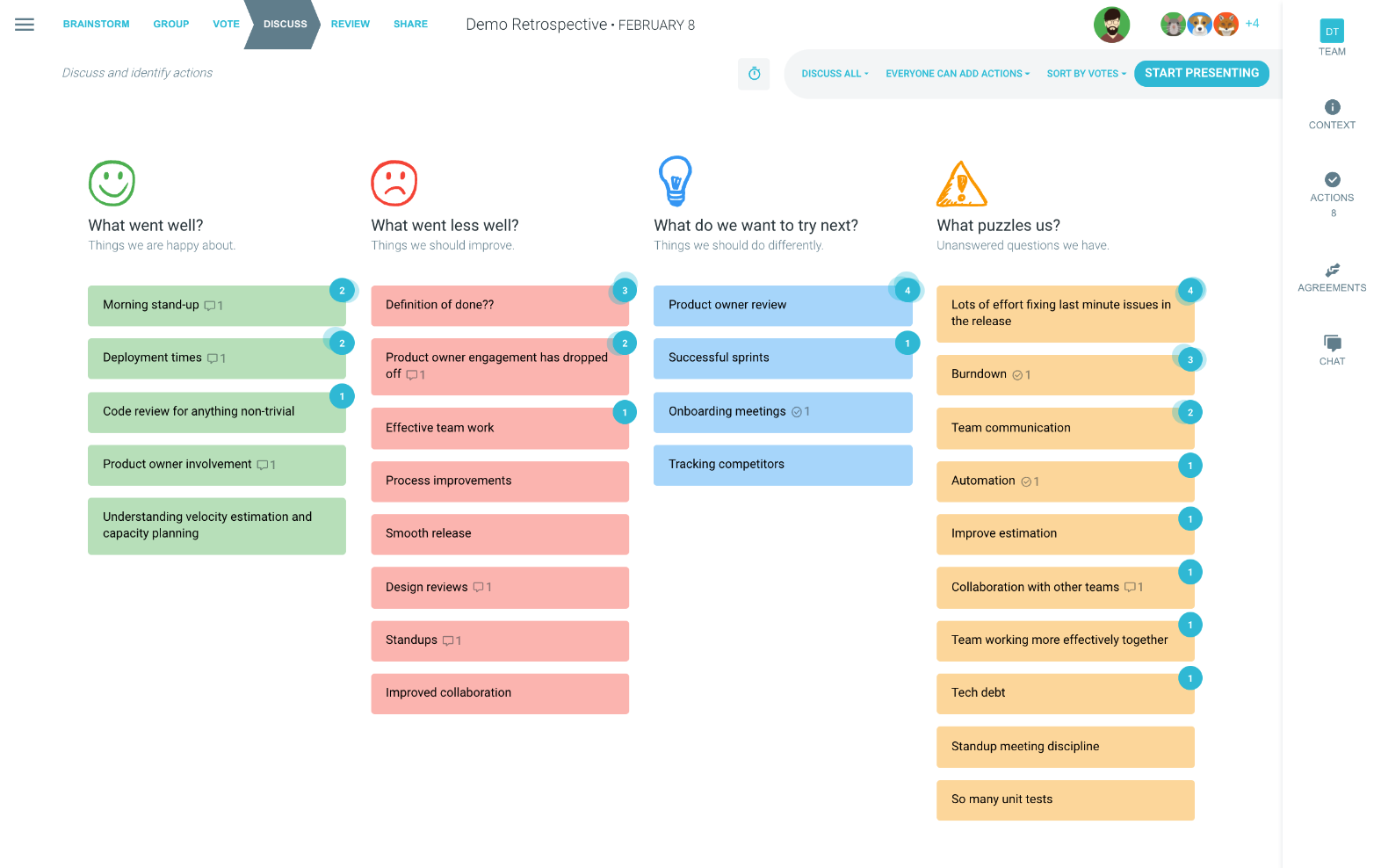Scrum Master’s Retrospective Guide
Your Complete Scrum Master’s Guide to Running Fun Easy and Effective Sprint Retrospectives
What is a Sprint retrospective?
What is a Sprint retrospective?
The “retro” as it is commonly referred to is an all-hands team meeting held on a regular basis with the goal of improving the way things work going forward, based on what they have learned from the past. They are also called scrum retrospectives, agile retrospectives, or post mortems.
They are run in fixed time frames at the end of each sprint (a set amount of work time). Generally, this is every 2 weeks.
A great team is one that continuously develops, learns, and grows. In Agile, there is no space that greater represents this than during the process of running a sprint retrospective.
Retrospectives allow everyone to share what they thought went well, and what didn’t. They can brainstorm new and improved ways of working for the upcoming sprint. This can either be by removing impediments, trying new ways of working, improving team morale, or engaging with stakeholders.
The team then looks for common themes, vote for the items that they feel are the most important, discuss those items and then agree on actions to take forward. These action steps form the basis of an agreed set of actions that allow the team to continuously inspect and adapt the way they work to improve the quality and velocity of their work.

Example of a sprint retrospective with dot voting (TeamRetro)
They are an important ceremony in Agile. It promotes continuous improvement and gives the team the opportunity to inspect and adapt on a regular basis. Your role as the Scrum Master as the servant leader is to help them do so effectively. It’s a crucial role that can be likened to the conductor of the orchestra, the facilitator of a meeting or the coach of a sports team.
What are the basic questions asked in a Sprint retrospective?
Who joins the Sprint retrospective meeting?
This is generally an all-hands meeting and can involve some or all of the following people
- The Scrum Master
- The whole development or scrum team
- Any key stakeholder heavily involved in or impacted by the work of the team
- The Product Owner
- An Agile Coach
- An observer

How long does a retrospective meeting run for?
This is usually based on the length of your sprint cycle. In general
- 2 Week Sprint: ~ 90 Minutes
- 1 Month Sprint: ~ 3 hours
- End of Iteration: ~ 1 day
What are the five stages of an effective retrospective?
Esther Derby and Diana Larsen are credited with defining the five key steps that make up the retrospective process. In their book, Agile Retrospectives: Making Good Teams Great, they break down the retrospective into stages. Each stage is designed to deliver a specific goal that, when combined, serves to support continuous improvement. The Scrum Master plays a vital role in the successful delivery of all five stages.
- Set the stage
As its name suggests, the aim of the first step of the retrospective process is to set a tone and direction for the retrospective meeting. In doing so, the space in which the retrospective will be ‘staged’ is defined. For the Scrum Master, this first step is all about getting organized, and that includes choosing a retrospective template. - Gather data
The second step sees the team share important information, highlights, insights, and outputs from their last sprint that are captured on the retrospective template. This stage marks the beginning of the retrospective meeting. It’s at this point that the Scrum Master assumes the role of meeting facilitator. - Generate insights
The goal of this step is to have the team look for patterns, themes and connections between the ideas.This is when a Scrum Master really starts to let their facilitation skills shine. In order to generate insights, everyone needs to have a shared understanding of each point. This is also the stage in the retrospective when similar ideas are grouped together, votes can be cast and the team can discuss the top-ranked ideas in greater detail. - Decide what to do
This step sees the generation and prioritization of valuable, clear actions. Again, the Scrum Master plays a key role here as they ensure that the conversation is focused, efficient and effective. - Summarize and end the meeting
This last step ensures that the action items are understood and the meeting is closed. Finally, the Scrum Master will share and follow up on the actions from the meeting.
We share what we have found helps to deliver each of these five steps in Chapter 7 – A checklist for running your agile retrospective.
4.8 on
Capterra





Trusted by 26,000+ agile teams and growing
Try it free for 30 days, no credit card required
Still have questions? SCHEDULE A DEMO